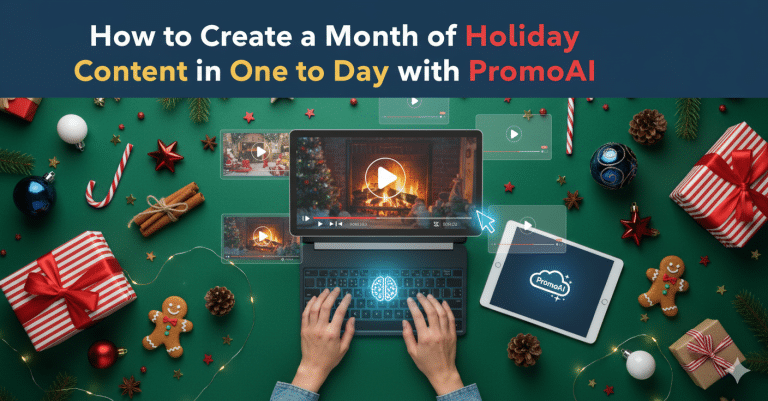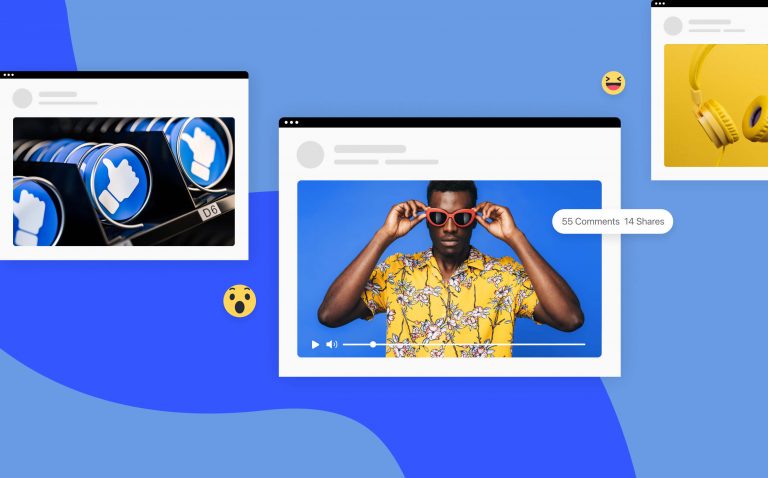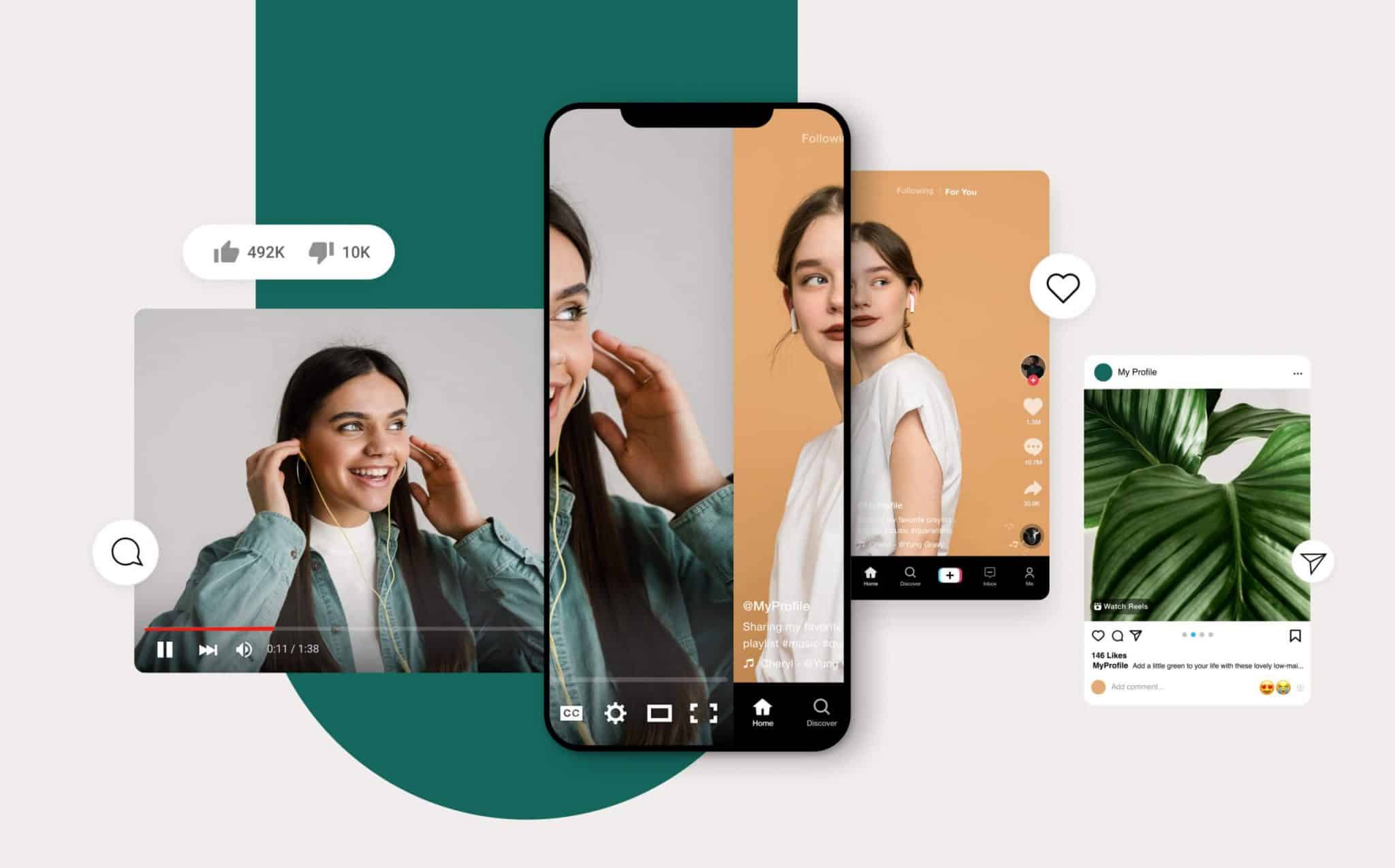
Social SEO 101: Exploring the Impact of Social Media on SEO
Social media SEO, or simply social SEO, is the practice of blending social media and SEO approaches in order to boost your search rankings.
Social and SEO campaigns are often created and run by different areas of a business, which can often mean that the strategies can fail to combine in a meaningful way. However, neither single approach can carry the burden in its entirety when it comes to climbing Google’s Search Engine Results Pages (SERPs).
By adopting an intelligent, data-driven and fully integrated digital marketing strategy that incorporates both social media and SEO, you can really create a significant boost to your ROI.
How Social Media & SEO Combine
Social media can impact your SEO efforts in many positive ways, and below is a list of the five most effective ways in which the two entities combine to boost the exposure and interest that your business can enjoy:
- SERPS: Social signals can influence the quality and engagement surrounding your website, directly impacting your search engine ranking positions.
- Amplifying Content: By amplifying your content you can help your output – whether it’s text, video, audio or pictorial content – to find new and existing visitors that operate beyond your organic reach.
- Brand Awareness: Building your presence online through social media can help to generate greater levels of trust and credibility in your brand.
- Link Building: One of the key benefits of social SEO, link building helps you to generate inbound backlinks when your content is discovered and reused by other websites.
- Local SEO: Geographically speaking, your social SEO efforts can also help to build social proof locally through business profile data and customer reviews.
Each area has a powerful range of social signals that can play a significant role in influencing your website’s SERPs. It’s for this reason that social SEO is vital for businesses of all sizes and across virtually all industries.

Source: The Future Buzz
As the diagram above shows, social SEO can be cyclical in terms of generating new customers and retaining them.
Although Google rules the roost in terms of queries, it’s worth sparing a thought for YouTube, which is not only a social media platform but also the second biggest search engine online. This means that your business could be missing out in harnessing the power of video content in winning new customers and driving them back to your pages.
This serves to illustrate just how complex the world of social SEO can be, but it also offers an insight into how influential it can be for your ROI. With this in mind, let’s take a lesson in Social SEO 101, and the key considerations your business needs to make before optimizing your marketing strategies:
The Art of Link Building
Arguably the most valuable facet of social SEO is also one of the hardest to incorporate into your marketing strategy. Although it’s not actually hard to implement, it relies heavily on external parties to link to your content responsibly. Link building is passive, and it depends on other websites or content creators to pick up your published text, video or images without you having to prompt them.
In simple terms, the art of link building boils down to using social media to promote your content. Site owners and creators can’t embed links to content they’re unaware of, and this process can take hours of effort with little success to show for it.
Organic and paid promotional content across social media platforms aren’t the only ways to make your brand more discoverable, but they should be considered essential if you’re looking to boost your profile.
If you create valuable content and utilize it in a social post, you’re essentially sharing your best work with the world – and it could be picked up and cited later on in external blog posts or columns, paving the way for excellent exposure.
Of course, it’s likely that your best work will be showcased away from social networks, where you have the space to write at length about subjects that are relevant. However, by sharing your work on your profiles, or featuring easy-to-find snippets, you can help to place link-worthy content under the noses of the people who will link to it across the web.
With this in mind, create a clear strategy for the social promotion of the content that you create, and include where you plan on sharing it – which could depend largely on the type of media you use. Set up a set of procedures to follow to give your work the best chance of being picked up and build a range of evergreen content that you can regularly reshare online so that your work can get maximum exposure over time.
Harness The Power of Video
Video marketing has become increasingly popular with businesses lately, especially as emerging technology, coupled with platforms like YouTube, has made it more simple than ever to create high quality, HD video content that can be professionally edited and shared with huge audiences.
According to Phil Nottingham, a video SEO expert at Wistia, “all websites can rank in the video tab, but not all can rank in universal search with a video. It’s become a lot harder to get whitelisted than it was about 3 years ago, but easier to get your video indexed on the video tab”.
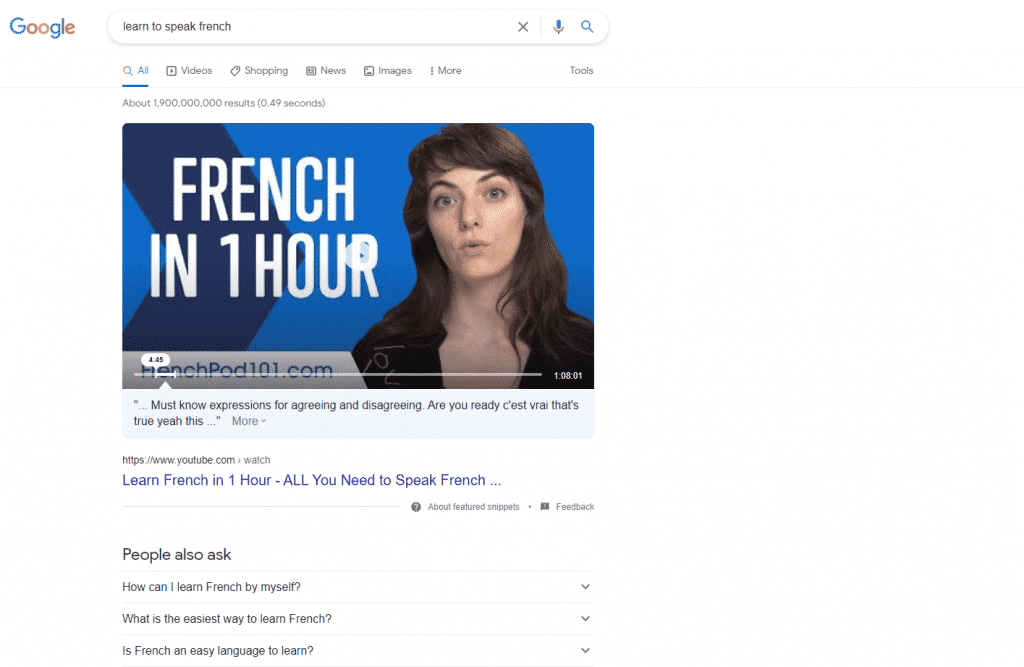
As we can see in the image above, there is a clear search engine benefit to uploading video content to YouTube, too – with Google’s algorithm prominently positioning videos before any other results.
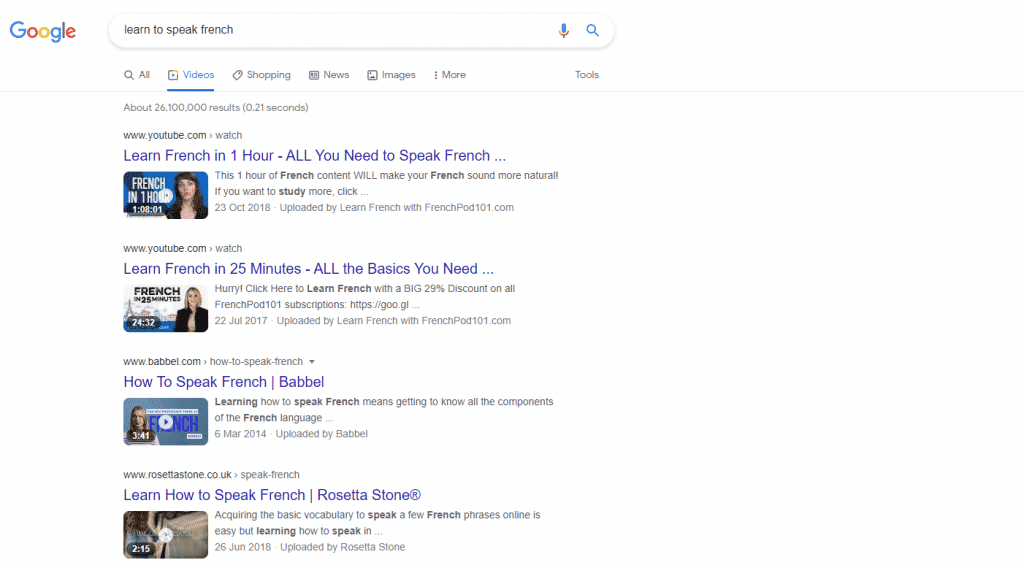
Notably, a search to ‘learn to speak French’ returns 1.9 billion results among Google’s results. Running the same query in video search returns around 26.1 million results – a 98.6% drop in the number of ranking competitors to outmuscle.
Social videos are shared 1,200% more frequently than both text and images combined. This shows that it’s high time for your business to embrace video content. The content you create will depend largely on your business model. By setting up tutorials, reviews, or product walkthroughs that can be easily shared across your social profiles and discoverable to audiences, you can essentially introduce customers to your expertise, products or services in a valuable way.
Build Sharable Content
Social media is designed to be a shared experience among users. For marketers, this can be interpreted as a great way to reach more consumers with their campaigns. In designing content that can easily be shared, you can reach more people and grow your brand awareness in a way that’s guaranteed to generate leads.
The task of getting your message out in the open is tricky if it’s not easy for individuals to share. In the world of social SEO, it’s not enough to simply create a blog post or video to share online with a standard description attached. By incorporating the right elements, like social share buttons within your website and strong call-to-actions (CTAs), it’s much easier to see your content spread its wings online.
By including these components as standard, you can encourage a far greater volume of social sharing, which will ultimately help boost your reach. Furthermore, when you post on social media sites, these CTAs can help your followers share your posts in greater numbers.

Sharable content can also be interactive, and you can encourage customers to build their brand loyalty by not only sharing your social media content but by replying to it as well.
In this example, Bariatric Foodie encourages its followers to share a selfie and communicate directly with the company. This helps to spread your content and also paves the way for users to generate their own content relevant to the brand – building a form of social proof in the process. FreshEssays specialist claims that in designing content that can easily be shared, you can reach more people and grow your brand awareness in a way that’s guaranteed to generate leads and improve SEO.
Traffic Insights Optimize Your Social SEO Strategy
With the help of analytics engines, it’s possible to identify and regard social traffic as its own entity – aiding your ability to closely monitor the success of your campaigns across various social networks.
You’re able to learn about your social strategies, how audiences interact with your campaigns and whether your content is really being discovered through the insights provided by platforms like Google Analytics and Finteza. These quality insights can include factors like:
- Whether your traffic from specific social platforms is engaging better or worse than traffic from other channels
- How your volume of social traffic is measuring up to organic, email and various other sources of traffic
- Which facets of your social media content are driving the most traffic

In the example from Finteza above, we can see that traffic sources are broken down by the social media referral links in which they come from – helping marketers to better understand who’s arriving from where, how they interact with their site, and how long their sessions typically last – helping to fine tune approaches and learn more about whether the right users are being targeted.
Discover Your Audience Wants and Needs
As you publish content on social media, it’s important to focus on your audience and monitor how they interact with your content. Are your videos, pictures and statuses leading to more engagement? Or is it being largely ignored?
Social SEO is an excellent way to understand your audience and to learn about what they want from you. You could find that some content isn’t a hit with your audience but other content wins plenty of engagement. With this in mind, it’s vital to learn from what works and what doesn’t and adapt your campaigns accordingly.
Learn what content drives engagement. Then you’ll be able to build more like-minded content. This content will be far better positioned to generate more leads and win more prospective customers.
Trends change all the time. The result is much more of a trial and error element to social media SEO. With this in mind, it’s vital to continually look for ways to improve and appeal to as many people as you can.
Social media is the place for the whole world to interact with one another, which means it should never be an afterthought for your business. In learning to create content that gets you noticed, the benefits are sure to be seen in your bottom line.

